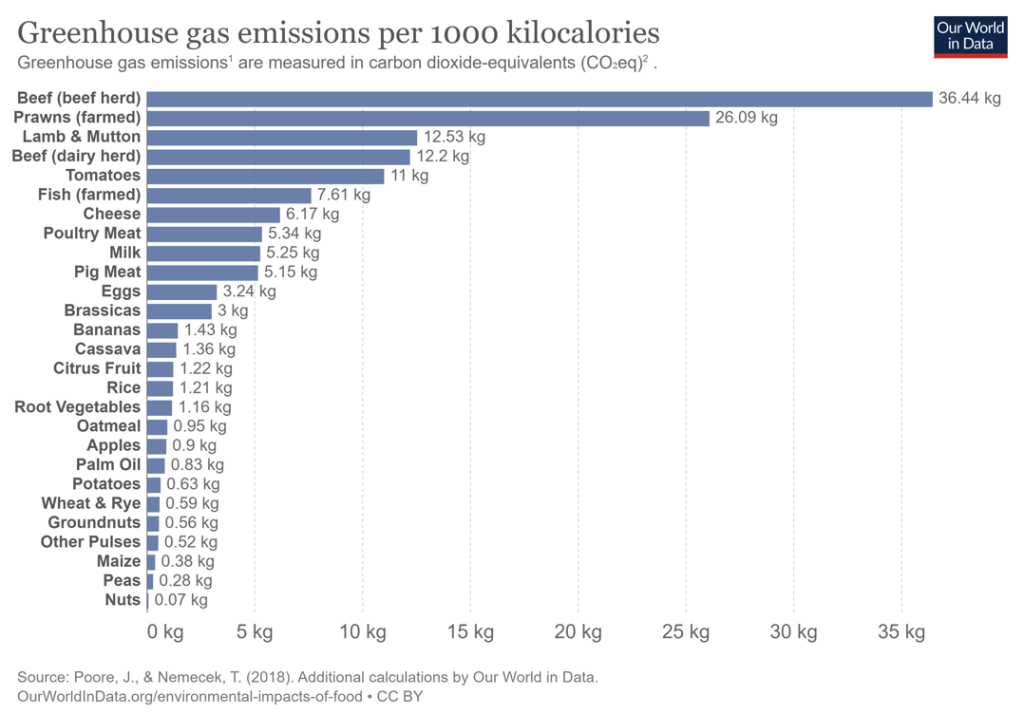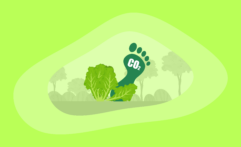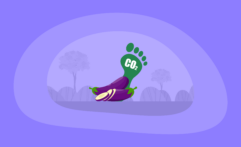What Is the Carbon Footprint of Kale? A Life-Cycle Analysis
Impactful Ninja is reader-supported. When you buy through links on our site, we may earn an affiliate commission.
Learn more
Learn more
.
Hey fellow impactful ninja ? You may have noticed that Impactful Ninja is all about providing helpful information to make a positive impact on the world and society. And that we love to link back to where we found all the information for each of our posts. Most of these links are informational-based for you to check out their primary sources with one click. But some of these links are so-called "affiliate links" to products that we recommend. First and foremost, because we believe that they add value to you. For example, when we wrote a post about the environmental impact of long showers, we came across an EPA recommendation to use WaterSense showerheads. So we linked to where you can find them. Or, for many of our posts, we also link to our favorite books on that topic so that you can get a much more holistic overview than one single blog post could provide. And when there is an affiliate program for these products, we sign up for it. For example, as Amazon Associates, we earn from qualifying purchases. First, and most importantly, we still only recommend products that we believe add value for you. When you buy something through one of our affiliate links, we may earn a small commission - but at no additional costs to you. And when you buy something through a link that is not an affiliate link, we won’t receive any commission but we’ll still be happy to have helped you. When we find products that we believe add value to you and the seller has an affiliate program, we sign up for it. When you buy something through one of our affiliate links, we may earn a small commission (at no extra costs to you). And at this point in time, all money is reinvested in sharing the most helpful content with you. This includes all operating costs for running this site and the content creation itself. You may have noticed by the way Impactful Ninja is operated that money is not the driving factor behind it. It is a passion project of mine and I love to share helpful information with you to make a positive impact on the world and society. However, it's a project in that I invest a lot of time and also quite some money. Eventually, my dream is to one day turn this passion project into my full-time job and provide even more helpful information. But that's still a long time to go. Stay impactful,Affiliate Disclosure
Why do we add these product links?
What do these affiliate links mean for you?
What do these affiliate links mean for us?
What does this mean for me personally?
![]()
Kale is the face of healthy-eating, and one of the most nutritionally dense foods around. Prior to the 90’s, kale was largely grown as an ornamental plant, before a meteoric rise in popularity. Whether in green smoothies, kale chips, or salads, you have likely heard of the superfood power of kale. However, much less is shared about the environmental impact, and especially the carbon emissions of kale. So we had to ask: What is the carbon footprint of kale?
Kale has a carbon footprint of 0.27 kg (0.6 lb) of CO2e per pound of produce. This is average compared to other vegetables. The growing process of kale uses many carbon-intensive resources. Packaged and processed kale also produces more carbon emissions than whole, loose kale.
In this article, we’ll walk you through the overall carbon emissions of the life-cycle of kale. From growing and packaging, to transportation and end-of-life practices, you will learn how this vegetable affects the planet and discover some ways to reduce and offset the footprint.
Here’s How We Assessed the Carbon Footprint of Kale
The carbon footprint is one of the ways we measure the effects of our human-induced global climate change. It primarily focuses on the greenhouse gas (GHG) emissions associated with consumption, but also includes other emissions such as methane (CH4), nitrous oxide, and chlorofluorocarbons, and is generally expressed in carbon dioxide equivalents (CO2e).
“Carbon footprint: the amount of greenhouse gases and specifically carbon dioxide emitted by something (such as a person’s activities or a product’s manufacture and transport) during a given period”
Merriam Webster
Basically, it is the amount of carbon emitted by you as an individual or an organization providing you with goods and services – including kale:
- This includes GHG emissions from producing the products that we use and foods that we eat (e.g., power plants, factories or farms, and landfills)
- GHG emissions from fuel that we burn directly or indirectly (e.g., logistics and transportation, cooling or heating facilities),
- as well as the GHG emissions attributed to how we consume these products and foods.
To understand the carbon footprint of kale, we must assess its life-cycle and each stage’s sustainability. This life-cycle assessment (LCA) is a method to evaluate the environmental impacts of products and materials.
Here’s the Overall Carbon Footprint of Kale
The overall carbon footprint of kale is 0.27 kg (0.6 lb) of CO2e per pound of produce, which is fairly low. The carbon footprint of kale is similar to that of other cruciferous vegetables, like broccoli. It produces less than a third of the carbon emissions of cucumber.
| The carbon footprint of kale | 0.27 kg (0.6 lb) of CO2e per pound of kale |
So, let’s have a look at each stage of the LCA of kale!
| The life-cycle stages of kale | Each stage’s carbon footprint |
| Growing of kale | The carbon footprint of growing kale is 0.04 kg (0.1 lb) of CO2e per pound of produce, which makes up 23.80% of the overall carbon footprint of kale. This figure is relatively low because kale does not require an abundance of land or water. However, the use of pesticides increases the carbon footprint of this crop. |
| Harvesting, processing, and packaging of kale | The carbon footprint of harvesting, processing, and packaging kale is 0.18 kg (0.4 lb) of CO2e per pound of produce, which is equal to 58.62% of the overall carbon footprint. This is largely down to the frequent use of plastic packaging, which dramatically increases the carbon footprint of this crop. |
| Transporting of kale | The carbon footprint of transporting kale is <0.04 kg (<0.1 lb) of CO2e per pound of produce, which amounts to 17.58% of the overall carbon footprint. Kale can be grown across many US states, making it possible to buy locally. Locally grown produce has a smaller carbon footprint than produce imported from other countries. |
| End-of-life of kale | The carbon footprint of the end-of-life of kale is largely impacted by the amount of food and packaging wasted. Salad waste in general is one of the most wasted foods, with around 40% of salad mix bags being thrown away. Around 56,000 tonnes of avoidable cabbage waste (including kale) is discarded every year. |
These four stages can be broken down in more detail to understand the factors which impact the carbon footprint of kale.
What Is the Carbon Footprint of Growing Kale
The carbon footprint of growing kale is 0.04 kg (0.1 lb) of CO2e per pound of produce, which makes up 23.80% of the overall carbon footprint of kale. This figure is relatively low because kale does not require an abundance of land or water. However, the use of pesticides increases the carbon footprint of this crop.
Kale grows quickly and uses little land and water. Vertically farmed kale uses even less of these resources, meaning that the carbon footprint of this crop grown vertically is lower than that of traditionally farmed kale.
Which factors impact the carbon footprint of growing kale?
- How does kale grow: Kale is part of the cabbage family, and grows in rows above ground. It can be grown either in fields, greenhouses, or vertically. Technological advancements in sustainable greenhouses and vertical farming means that the growing process is becoming less carbon-intensive.
- What is the growth duration of kale: Depending on how tender a farmer wants the kale to be, this crop takes between 30-60 days to mature after germination. This is a short growth duration, so less resources need to be used on kale, in comparison to vegetables like asparagus, which have a far longer growth duration. Therefore, kale has a fairly low growth carbon footprint.
- What is the land usage of kale: Leafy greens can be incredibly land efficient, and are one of the most commonly grown crops on vertical farms. Vertical farming uses 10-20 times less land, making it far more carbon efficient than traditional farming. However, in non-vertical farms, kale plants have to be planted with space between each crop. Around 11-22 tons of kale is grown per hectare in fields or greenhouses, which makes it a fairly land efficient crop.
- What is the water usage of kale: Kale requires about 2.5cm of water per week. Drip irrigation is recommended to reduce water wastage. However, cruciferous vegetables tend to be low-water-intensity vegetables, making the carbon footprint lower than that of vegetables such as cucumber, which require a lot of water.
- What is the pesticide and fertilizer usage of kale: Kale is one of the worst offenders for pesticide use. The Environmental Working Group rated kale as the crop contaminated with the third highest rates of pesticides. 60% of kale plants were contaminated with residue of a pesticide considered a carcinogen. While this is a risk for health reasons, it also increases the carbon footprint, since pesticides produce carbon emissions through manufacturing, transportation, and application to crops.
In short, kale is relatively water- and land-efficient, giving the crop a low growing carbon footprint. However, this is lowered even further when grown vertically. The use of pesticides in kale increases the carbon footprint, making organic kale a less carbon-intensive crop than its non-organic counterpart.
What Is the Carbon Footprint of Harvesting, Processing, and Packaging Kale
The carbon footprint of harvesting, processing, and packaging kale is 0.18 kg (0.4 lb) of CO2e per pound of produce, which is equal to 58.62% of the overall carbon footprint. This is largely down to the frequent use of plastic packaging, which dramatically increases the carbon footprint of this crop.
Bagged, pre-cut kale is often seen as a more convenient option to buying whole, fresh kale. However, the processing and packaging leads to higher levels of carbon emissions.
Which factors impact the carbon footprint of harvesting, processing, and packaging kale?
- How is kale harvested: Kale is usually harvested by hand, so the produce is not damaged by machine-harvesting. This process involves farmers pulling up mature leaves and bundling them together. This is a labor-intensive process, but does not require machine harvesters, which have a very high carbon footprint.
- How is kale processed: Processed, pre-cut kale is incredibly popular, and bagged kale is offered as a more convenient alternative to bunches of kale. Kale can also be sold frozen, powdered, or in ready-to-eat meals, or smoothies. This level of processing has a large impact on the carbon footprint of this product. The machines and processing plants require vast amounts of energy and release carbon emissions.
- How is kale packaged: Unprocessed kale is either sold loose, in bundles of leaves, or packaged in polyethylene bags. Processed kale is almost always sold in plastic, polyethylene bags. Due to the prevalence of processed, pre-packaged kale, the packaging stage of kale contributes a lot of carbon emissions to the overall carbon footprint. However, scientists are trying to develop an edible, biodegradable packaging made out of kale puree, which hopefully one day will lead to less plastic waste.
In short, processed kale tends to be sold in plastic, which has a significant impact on increasing the carbon footprint of this crop.
What Is the Carbon Footprint of Transporting of Kale
The carbon footprint of transporting kale is <0.04 kg (<0.1 lb) of CO2e per pound of produce, which amounts to 17.58% of the overall carbon footprint. Kale can be grown across many US states, making it possible to buy locally. Locally grown produce has a smaller carbon footprint than produce imported from other countries.
The majority of kale grows in California and Georgia, but can also be imported from Mexico or Canada. Opt for locally grown kale to reduce your personal carbon footprint.
Which factors impact the carbon footprint of transporting kale?
- Where are kale grown: Kale is grown predominantly in California and Georgia, but can thrive across many states that have a cool growing period in the fall. This means that the food miles of kale are low, as the crop can be grown locally. However, America imports 14.9% of the world imports of brassicas, largely from Mexico and Canada, which increases the carbon footprint. Opt for locally grown kale to reduce the carbon emissions of your purchase.
- How are kale transported: Kale is transported largely by truck, but can also be shipped by boat, rail, or air. Like most fresh produce, kale requires constant refrigeration during transportation. Kale needs to be kept at a cool 32-36°F to prevent premature spoilage. Unfortunately, refrigerated vehicles can emit up to 29 times more potentially carcinogenic particulate matter and six times more nitrogen oxides than far larger, modern diesel truck engines. If kale is purchased from a local farm, the carbon footprint is decreased.
In short, locally grown produce requires less transportation and time in refrigerated vehicles than imported crops. If you can, buy kale from local farmers to ensure you have a smaller carbon footprint.
What Is the Carbon Footprint of the End-of-Life of Kale
The carbon footprint of the end-of-life of kale is largely impacted by the amount of food and packaging wasted. Salad waste in general is one of the most wasted foods, with around 40% of salad mix bags being thrown away. Around 56,000 tonnes of avoidable cabbage waste (including kale) is discarded every year.
Kale only has a shelf life of about a week, which is why it is frequently wasted. Since pre-cut kale is almost always sold in plastic packaging, the carbon footprint of processed kale is higher than that of whole kale sold loose.
Which factors impact the carbon footprint of the end-of-life of kale?
- How is kale disposed of: Around 56,000 tonnes of avoidable cabbage waste (including kale) is discarded every year. Kale is completely compostable but often ends up in landfill, which is a big problem for the environment. 16% of all food is wasted on farms, largely for aesthetic reasons. The resources used to grow these crops just to discard them are enormous, and negatively impact the carbon footprint of kale.
- How is the packaging of kale disposed of: Kale is often sold packaged in plastic, whether processed or not. Many of the polyethylene bags used for packaging are recyclable, as long as the polyethylene is not bonded with other plastics. This is because polyethylene is generally only recycled to make like-for-like products. However, a lot of plastic that we recycle ends up on the other side of the world, causing a threat to developing countries. So, it is much more sustainable to buy loose produce.
In short, kale is often wasted due to a short shelf-life. Kale is usually packaged in plastic, which contributes negatively to the carbon footprint.
How Does the Carbon Footprint of Kale Compare to Other Types of Food
Kale has a relatively low carbon footprint. In comparison to other popular vegetables, it ranks alongside broccoli and celery. So, if you are looking for a low-carbon snack that is also super healthy, reach for some kale.
Let’s see how kale ranks in comparison to other types of vegetables.
How Does the Carbon Footprint of Kale Compare to Other Types of Vegetables
In comparison to other vegetables, the carbon footprint of kale is average. For example, cucumbers produce nearly three times the carbon emissions of kale. Salad vegetables need more resources to grow, making their carbon footprint far higher than root vegetables. This is why kale has a carbon footprint that is around three times higher than onions.
So, kale has a relatively low carbon footprint in comparison with other vegetables. But how does it compare to other types of food?
How Does the Carbon Footprint of Kale Compare to Other Types of Food in General
Like brassicas, kale is one of the more sustainable options in comparison to other types of food. It produces around twelve times less greenhouse gas emissions than beef.
When it comes to greenhouse gas emissions (GHG), foods are often compared in terms of emissions per 1,000 kilocalories (as opposed to their weight in lbs or kg).

However, since kale is extremely low in calories, a far greater amount of produce is needed to equal 1,000 kilocalories.
- To eat 1,000 kilocalories, you would need to consume 30 servings, or around 105 ounces.
- In comparison to beef you would only need 4.6 servings to eat 1,000 kilocalories, or 16 ounces.
- Comparatively, kale has a high carbon footprint per kilocalorie, but is enormously less calorific than animal-based food.
- More calorific plant-based foods, such as pulses and nuts, have a minuscule carbon footprint in comparison to animal-based proteins. A single portion of beef amounts to around 6.5 portions of kale, in terms of calories.
- This means that per portion, you will be consuming fewer calories, and so the carbon footprint will not be as large as this graph suggests.
Even though the carbon emissions for kale is low in comparison to other types of food, try to be mindful of the ways you can lessen your environmental impact when you purchase it.
How Can You Reduce and Offset Your Personal Carbon Footprint
All of the food you eat will have some form of carbon footprint, even when you buy foods with low CO2e, such as kale. However, there are ways to offset and reduce your personal carbon footprint.
There are a few easy techniques to buy more eco-friendly kale, and you can also find ways to offset the carbon footprint after your purchase.
How Can You Reduce Your Carbon Footprint When Shopping for Kale
When shopping for kale, consider these ways to lessen your impact on the environment.
- Shop locally and seasonally: Kale is a leafy green which thrives in cooler temperatures. Look out for kale from late summer onwards. Buying from local farms reduces the carbon emissions produced and makes it a much more sustainable choice.
- Choose organic: Organic kale produces a much lower carbon footprint than non-organic vegetables, due to the lack of pesticide production, distribution, and the overall higher health of soil for crops, insects, and animals.
- Avoid waste: Kale can often end up going bad in the refrigerator. Avoid this by storing your kale correctly, and consuming it quickly. Leaves that are looking a bit wilted can sometimes be revived after a soak in iced water. You can also freeze kale to increase the shelf life, and use kale stems in a variety of recipes.
Taking these actions are a great way to lessen your own carbon footprint, but there are also ways to offset the impact of consuming kale as well.
How Can You Offset Your Personal Carbon Footprint
Carbon offsets are reductions in carbon emissions that are used to compensate for carbon emissions occurring elsewhere – for example for the carbon emissions that are associated with kale. They are measured in tons of CO2 equivalents and are bought and sold through international brokers, online retailers, and trading platforms on what is known as the global carbon offset market.
“Carbon Offset: a way for a company or person to reduce the level of carbon dioxide for which they are responsible by paying money to a company that works to reduce the total amount produced in the world, for example by planting trees”
Oxford Dictionary
In terms of kale – and indeed all food types – there will always be a carbon footprint, because of the resources it takes to get your food from farms to the place where you’ll eventually eat them. And while there are ways to reduce your carbon footprint when shopping for kale, carbon offsets would be a way to reduce your CO2e emissions all the way down to net zero (or even to become climate positive).
However, when you purchase carbon offsets, it’s important that they actually make a difference in offsetting (aka reducing) total carbon emissions. To achieve that, the following are key criteria:
- Carbon offset projects have to be effective (different projects have different effectiveness rates)
- Carbon offset projects have to be additional
- Carbon offset projects have to be permanent
- The claims from carbon offset projects have to be verifiable
To find the best carbon offsets for you personally, check out our full guide on the best carbon offsets for individuals, where you’ll also learn more about how these carbon offset projects work, what their respective offsetting costs are, and what your best way would be to offset your own carbon emissions.
Final Thoughts
Kale has a relatively low carbon footprint when compared with other vegetables and an even lower carbon footprint when compared with other foods. However, you can try to reduce your carbon footprint even further by eating organic, reducing food and plastic waste, and purchasing local, seasonal produce. When you do enjoy kale, think about whether you can offset the carbon emissions created, to make this healthy vegetable a more sustainable option!
Stay impactful,

Sources
- Crop Drop: Kale
- Mayo Clinic Health System: Kale: Discover the ‘secret powers’ of this superfood
- Britannica: Carbon footprint
- Science Direct: Life-cycle assessment (LCA)
- MIT SMR: Strategic Sustainability Uses of Life-Cycle Analysis
- Carbon Cloud: Chopped Kale
- Impactful Ninja: What Is the Carbon Footprint of Broccoli
- Impactful Ninja: What Is the Carbon Footprint of Cucumber
- The Guardian: Salad days soon over: consumers throw away 40% of bagged leaves
- WRAP: The Food We Waste
- P. L. Light Systems Expert Articles: Pros and Cons of Growing Leafy Greens in a Vertical Farm
- Forbes: Growing Leafy Greens In Massive, Sustainable Greenhouses
- Greenhouse Emporium: How To Grow Kale in a Greenhouse
- National Geographic: The Surprisingly Big Carbon Shadow Cast By Slender Asparagus
- Business Wales: Farming Connect: Vertical Farming: A new future for food production?
- AgriFarming: Kale Cultivation
- University of Saskatchewan: Kale
- Utah State University: Kale in the Garden
- Futurity: These Foods Have the Highest Water Scarcity Footprint
- Environmental Working Group: EWG’s 2023 Shopper’s Guide to Pesticides in Produce™
- Environmental Working Group: More than half of kale samples tainted by possibly cancer-causing pesticide
- The Produce Nerd: Kale Harvest and Packaging
- Farms Wise: Are Tractors Bad for the Environment?
- Cooks Illustrated: Why You Should Buy Kale in Bunches, Not Bags
- Good Food: Clear packaging unwraps potential for kale
- Science Direct: A sustainable approach on the potential use of kale puree in edible wraps
- Food Source Information: Kale
- Trend Economy: Cabbages, cauliflowers, kohlrabi, kale | Imports and Exports | 2021
- LSU Agricultural Centre: Transportation of Fresh Produce: Best Practices To Ensure On-farm Food Safety
- The ACR Journal: Refrigerated vehicles contribute to thousands of deaths and costs across EU
- World Wildlife Fund: Fight climate change by preventing food waste
- World Wildlife Fund: What farmers found when they measured fresh produce left in the field
- Let’s Recycle: Supermarkets to take back plastic film in-store
- Sesotec: Recycling more packaging –potential for PE and PP
- Live Science: The Plastic We ‘Recycle’ Is Actually Horrible for the Environment
- Impactful Ninja: What Is the Carbon Footprint of Onions
- Impactful Ninja: What Is the Carbon Footprint of Tomatoes
- Impactful Ninja: What Is the Carbon Footprint of Bell Peppers
- Impactful Ninja: What Is the Carbon Footprint of Salad Mix
- Impactful Ninja: What Is the Carbon Footprint of Broccoli
- Impactful Ninja: What Is the Carbon Footprint of Celery
- Impactful Ninja: What Is the Carbon Footprint of Carrots
- Impactful Ninja: What Is the Carbon Footprint of Potatoes
- Our World in Data: Greenhouse Gas Emissions per 1,000 kilocalories
- WebMD: Kale
- Healthline: Beef 101: Nutrition Facts and Health Effects
- Bon Appetit: How to Buy, Store, and Cook With Kale, in Season in September
- Columbia Climate School: Is Organic Food Really Better for the Environment?
- Foolproof Living: How To Store Kale
- Epicurious: 11 Ways to Eat Kale Stems—Even If You Didn’t Know You Could
- Impactful Ninja: 12 Best Carbon Offsets for Individuals




